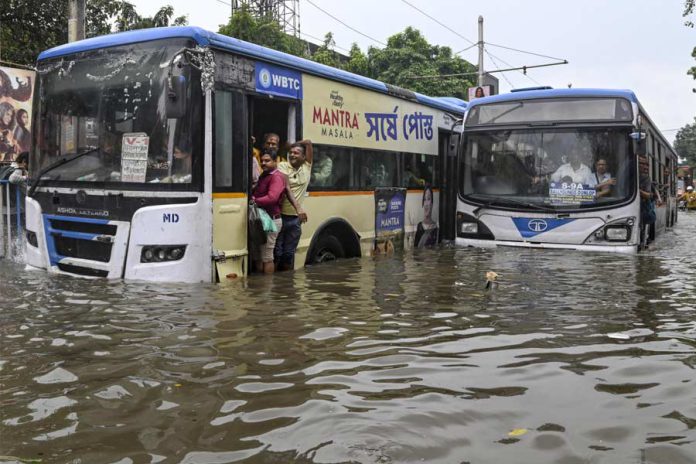Kolkata floods after 251 mm rainfall expose drainage failure, flight and train chaos, deaths from electrocution, and government neglect ahead of Durga Puja.
By Dr. Mohammad Farooque
Kolkata| September 24, 2025
Kolkata has once again sunk under the weight of its own broken systems and failed governance. From Monday night into Tuesday morning, torrential rains battered the city so badly that trains halted, flights were delayed or canceled, and even basic public services collapsed. According to the Alipore Meteorological Department, the city received 251.4 mm of rain in just 24 hours, with 185.6 mm pouring down in three hours alone. At one point, rainfall hit 98 mm in a single hour—just shy of being officially classified as a “cloudburst.” Streets in both north and south Kolkata turned into rivers, water climbed from knees to chest level, slum homes went under, and families were trapped inside their own houses.
These figures don’t just tell the story of an extreme weather event—they expose the inefficiency of the government and the hollow promises of the municipal system. Kolkata Municipal Corporation and Mayor Firhad Hakim kept repeating the same excuse: “Where will the water go? Everything is flooded.” But the real question is, where have the taxpayers’ money and decades of development claims gone? Why does a 350-year-old metropolis still not have an effective drainage system? While Mumbai, despite its encroachments, has worked to strengthen its network, and Delhi is preparing for future floods with billion-rupee projects, Kolkata continues to drown in negligence and empty declarations.
Train services collapsed across the Sealdah and Howrah divisions, where submerged tracks forced the cancellation of not only local trains but also major services like Vande Bharat Express, Shatabdi, Black Diamond, and Gana Devata. The airport was no better—pilots and crew could not reach on time, leading to cancellations and widespread delays of domestic and international flights.
This crisis was not unforeseen. The Meteorological Department had already warned that a depression over the northeast Bay of Bengal would intensify. Yet, there was no effort to prepare drainage systems or secure the fragile electricity network. The cost of that inaction was deadly: dozens lost their lives, many electrocuted as live wires turned flooded streets into death traps. From Hussain Shah Road and Netaji Nagar to Behala and Gariahat, deaths stretched across the city. Chief Minister Mamata Banerjee’s criticism of the Calcutta Electric Supply Corporation may be justified, but who handed over the city’s power supply to this private company and ignored its lapses for years? The responsibility circles back to the government itself.
The education system, too, crumbled in the storm. Calcutta University canceled all its exams, while other central institutions failed to even issue timely notifications, forcing students to risk their lives on flooded streets. The Chief Minister later announced an early Puja break for schools and colleges—but wasn’t this a reaction to public outrage rather than a proactive safety measure?
And what of Durga Puja, Bengal’s grandest festival, just days away? Waterlogged pandals, shuttered markets, and businesses on the brink of losses worth billions paint a grim picture. Advising citizens to “stay indoors” is no solution when commuters remain stranded at stations in Serampore, Dattapukur, Bongaon, or Hasanabad; when water pools inside the airport itself; and when families in low-lying wards are forced to spend nights on rooftops. This isn’t simply rainfall—it’s an epitaph for administrative failure.
At a time when India speaks of modern urban planning and ambitious growth, Kolkata weeps like a wounded city. No modern systems, no proactive mayor, no citizen-centered planning—only temporary announcements and token holidays. Unless the city’s funds and the state’s capacities are urgently directed toward real drainage networks and stronger infrastructure, each bout of rain, each festival, and each flood will drag Kolkata into the same cycle of helplessness, death, and collective despair.
This is the hour for accountability. Citizens must ask how long they are expected to tolerate a mayor who hides behind excuses, a corporation that offers only statements, and a government that has failed to fix drainage, modernize electricity, or learn from repeated disasters. Kolkata is not merely waterlogged—it is drowning in the broken promises that have been repeated for decades.







